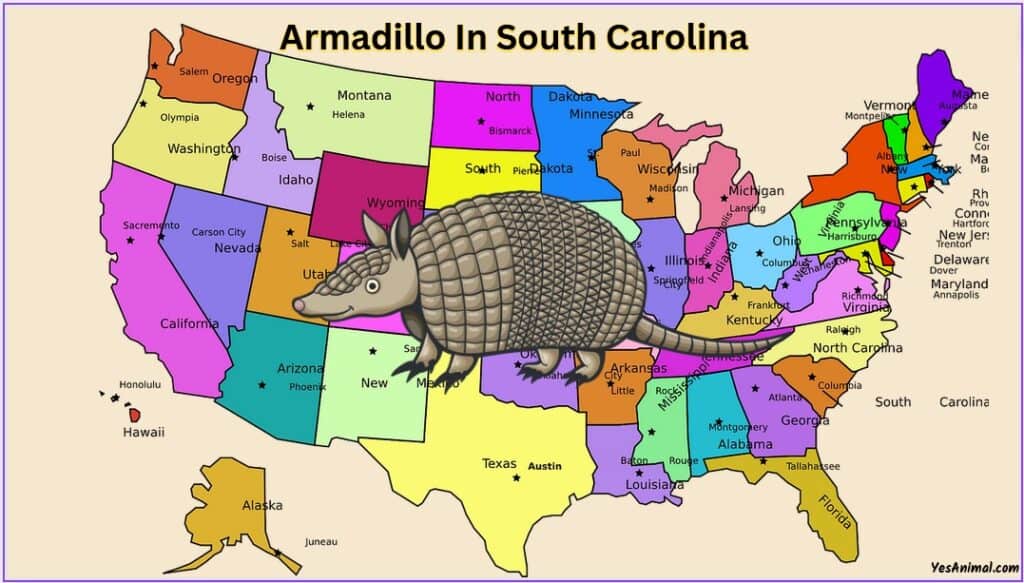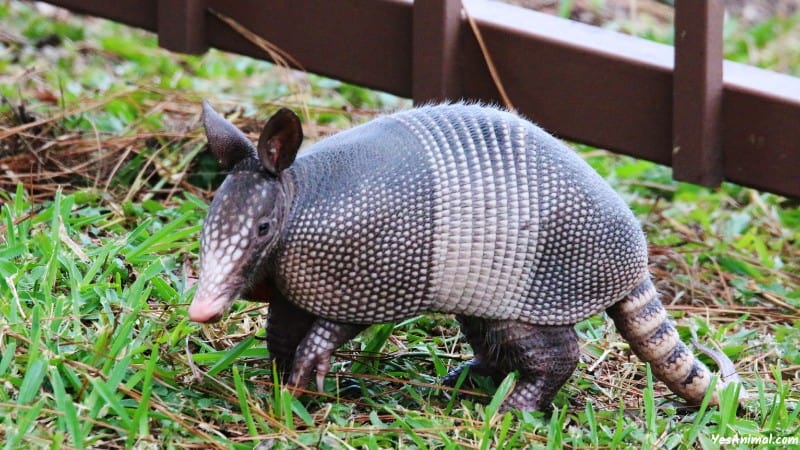Last Updated on September 14, 2023 by Amin Tawar

South Carolina is a small state in the United States, but it has three geographic areas, with hot summers, mild winters, and humid summers. It is a utopia for all types of wildlife, from amphibians to small rodents including the — Armadillo.
Below In this article, I’ve explained everything you need to know about the Armadillo In South Carolina.
Are There Armadillo In South Carolina?
Yes, there are Armadillos In the state of South Carolina. An increasing number of holes have been discovered in fields and yards across the state of South Carolina.
The origin of these holes are determined to be a species that has been making its way into South Carolina from Central America and Florida for years— it is the armadillo. Armadillos have extended from North Carolina to Texas East and Nebraska, as well as traveling up from Florida.
South Carolina Armadillo Population
It is quite difficult to pin point the exact number of Armadillos in the State but I can assure you that they’re thriving. Armadillo has been spreading throughout the state of South Carolina and the bony scales of armor easily identify it.
Today, these nine-banded armadillos are found even in the state’s northern part. There are also increasing statements of armadillos being present in North Carolina.
The species have established a huge population in South Carolina and continued its movement even into other states. Also, armadillos typically live up to 20 years and give birth every once a year, delivering either four female or male armadillos.
Also, the very little desire of Americans to eat or hunt armadillos and their high reproductive rate of them has made them more in population.
How Common Are Armadillos In South Carolina?

Lately, it looks like they have just taken off, as they have extended from the sandy ground of the lower Savannah River region into places such as the mountains and Piedmont, which has thick clay ground, which is more difficult for them to dig.
Initially, they were found only in sandier-soil kinds of counties, which makes digging easy. But now they have moved Upstate, where it is not easy about digging the clay. And this has not seemed to stop them.
The Department of Natural Resources states that there have been a lot of complaints about armadillos rooting up lawns. Though they do not harm humans, they can do extensive property damage.
The DNR has also stated that people complain saying that they have suddenly got a bunch of holes in their yard. They normally show up in the afternoon and with their really strong claws, they burrow quickly.
Also Check Out Our Guide On Armadillo in US
How Did Armadillos Get To South Carolina?
In the journey of Armadillo into the state of South Carolina, the Savannah River cannot offer much of a border and scientists have observed how they have been growing in numbers. This is because they can swim and can walk on the base of shallow water.
In 1995, armadillos were seen only in the lower tip of South Carolina, and within a few years, they had moved across most of the state. In 2009, even North Carolina started viewing the population establishment of a hunting season for these species, following the information that these species have moved into the southern spaces of the state.
Why Are Armadillos Coming To South Carolina?
This is not much because anything around the state itself is fantastic for them, though. Rather, once these nine-banded armadillos began spreading around the U.S. during the 19th century, places that had warm climates and rare predators that are available in their migration destinations. They also like to live in grasslands or forested habitats.
South Carolina fits all of this bill adequately for an average armadillo’s living conditions, and it has no lack of other animals that are scrumptious food sources by their measures.
Scientists are not very sure why they have been moving their habitat into South Carolina. But it looks like warmer temperatures because of the earth’s changing climate can be a huge factor. Or it can also be simply they found an opportunity and reached for it.
What Is The South Carolina Armadillo Called?
The South Carolina Armadillo is called a nine-banded armadillo, or a nine-banded long-nosed armadillo. There are more than 20 species of armadillo, but only the nine-banded exist in the U.S.
The word “armadillo” in Spanish represents “small armored one”, and refers to the presence of lean, armor-like scales wrapping its body. The nine-banded armadillos have 9 to 11 plates on their armor. Unlike other armadillos, the nine-banded armadillos cannot roll up into a spherical ball.
Can You Kill An Armadillo In South Carolina?
Yes, you can hunt armadillos in South Carolina. A hunting license is needed, however, there is no closed hunting season for hunting armadillos on privately owned land in the state during daylight hours.
The usage of electronic calls and bait is also legal on private lands. Armadillos can be hunted at dark on a documented property on which an individual has lawful ownership to hunt, utilizing any legal gun, crossbow, or bow and arrow.
This includes the usage of electronic calls, bait, and night vision devices. You can also trap armadillos that are damaging your property. You can set a trap along the natural barriers of buildings to increase the chance of catching them.
Also, there are no toxicants or repellents registered against the use of armadillos. You can try using pesticides to control the populations in your landscape.
Can You Own An Armadillo In South Carolina?
In South Carolina, you cannot own armadillos as pets. This is because they are not a native species of the state and can become aggressive when in captive.
Also, they would not make a perfect pet for most as they are nocturnal, and if kept inside, they damage your property. Please check with the state officials before trying to keep an armadillo as a pet.
Also Check Our Guide On Armadillo In Missouri
Conclusion
And that was everything you need to know about the Armadillo In South Carolina. I hope this article answered all your queries.
Thank You For Reading!
Our Source For This Guide